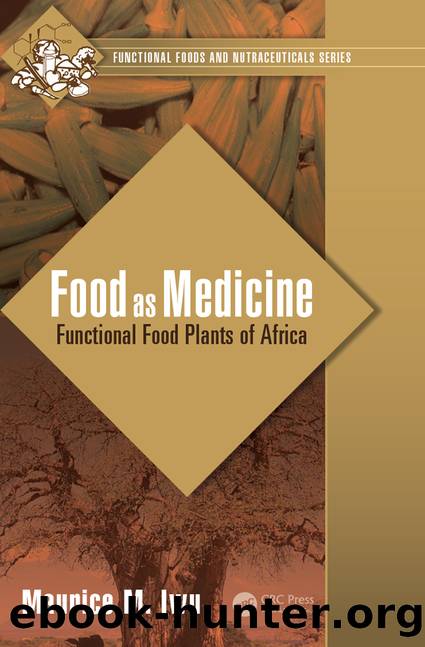Food As Medicine by Iwu Maurice M.;

Author:Iwu, Maurice M.;
Language: eng
Format: epub
Publisher: CRC Press LLC
An evaluation of the efficacy of “buchu” oil applied topically to treat pain resulting from muscle damage has been conducted by the Research Unit of Exercise and Sports Medicine, University of Cape Town, South Africa. In the study, 30 male participants did a bout of exercise using their nondominant arm with the intention of causing exercise-induced muscle damage. The results from the double-blind placebo-controlled trial indicated that the group treated three times daily with buchu gel showed a reduction in swelling, which may be ascribed to the anti-inflammatory properties of buchu.
Toxicity: The extracts of A. betulina and A. crenulata were shown to be nontoxic at the concentrations tested (IC50 values > 100 μg/mL) using the MTT (3-[4,5-dimethyl-2-thiazolyl]-2,5-diphenyl-2H-tetrazolium bromide) cellular viability assay. In the same assay, the essential oils proved to exhibit higher toxicity at the concentration tested, both having IC50 values of <0.0001 μg/mL when compared to the control.150 The compound cis-isopulegone present in both species may contribute to the observed toxicity. R-(+)-pulegone is known to be a hepatotoxic compound, where large oral doses have been shown to deplete glutathione, which is needed in one of several biological detoxification steps. This depletion along with excess pulegone leads to centrilobar hepatocellular necrosis.
Formulation and Dosage Forms: The leaves are usually air-dried and may be steam-distilled to obtain the oil. Apart from its use in the dietary supplement industry, it is a major ingredient in the flavor and fragrance industry where buchu is used to enhance fruit flavors. It is particularly used to boost blackcurrant-like flavors. Its fragrance has a minty camphoraceous, sweet berry, catty, tropical guava, apricot and peach, green herbal taste. The oil is also used in perfumes and colognes. Several proprietary products exist in which buchu is used either alone or in combination with ginger, G. kola, Curcuma longa for arthritis, and with G. kola and Cola nitida (InterCEDD Health Products) as a “hangover” tonic.
Commerce: The two species of Agathosma are articles of international trade. The crude drug as well as the volatile oils are traded extensively. Herbalists and trade associations in South Africa export buchu to Europe, especially Germany and France. Although producer prices have fluctuated wildly in recent years, the demand for this crop has been stable in the last decade. According to the Market News Service (MNS) Bulletin on Medicinal Plants and Extracts—2011, the wholesale price of dried leaves of buchu is 38.36 USD/kg on CIF terms.
Agriculture: Buchu is restricted to South Africa and is a typical component of the fynbos vegetation of the Cape region. Although some cultivation has been embarked on since the 1970s to raise improved varieties with more desirable properties, most of the commercial products are still wild-crafted. Recent efforts in crop development have resulted in buchu now being a viable option for small-scale farming. Recently, growers experienced severe losses, ascribed to a soil-borne disease. The bioequivalence of some of the hybrids and cultivars is yet to be determined so it is therefore important that only products obtained from A. betulina should be
Download
This site does not store any files on its server. We only index and link to content provided by other sites. Please contact the content providers to delete copyright contents if any and email us, we'll remove relevant links or contents immediately.
| Anatomy | Animals |
| Bacteriology | Biochemistry |
| Bioelectricity | Bioinformatics |
| Biology | Biophysics |
| Biotechnology | Botany |
| Ecology | Genetics |
| Paleontology | Plants |
| Taxonomic Classification | Zoology |
Sapiens: A Brief History of Humankind by Yuval Noah Harari(14257)
The Tidewater Tales by John Barth(12609)
Mastermind: How to Think Like Sherlock Holmes by Maria Konnikova(7233)
Do No Harm Stories of Life, Death and Brain Surgery by Henry Marsh(6891)
The Thirst by Nesbo Jo(6832)
Why We Sleep: Unlocking the Power of Sleep and Dreams by Matthew Walker(6620)
Life 3.0: Being Human in the Age of Artificial Intelligence by Tegmark Max(5478)
Sapiens by Yuval Noah Harari(5295)
The Longevity Diet by Valter Longo(5021)
The Body: A Guide for Occupants by Bill Bryson(4978)
The Rules Do Not Apply by Ariel Levy(4866)
The Immortal Life of Henrietta Lacks by Rebecca Skloot(4528)
Animal Frequency by Melissa Alvarez(4399)
Why We Sleep by Matthew Walker(4362)
The Hacking of the American Mind by Robert H. Lustig(4319)
Yoga Anatomy by Kaminoff Leslie(4309)
All Creatures Great and Small by James Herriot(4233)
Double Down (Diary of a Wimpy Kid Book 11) by Jeff Kinney(4209)
Embedded Programming with Modern C++ Cookbook by Igor Viarheichyk(4108)
